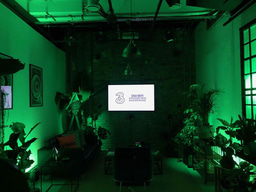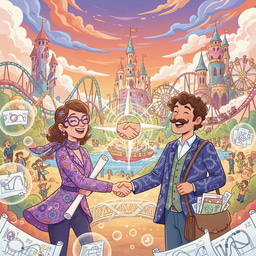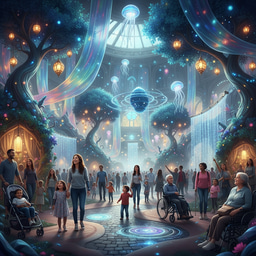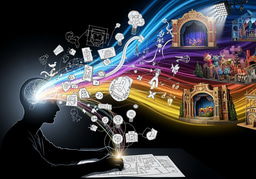The Future is Now: Technology in Spatial Design

This is part of our Spatial Design blog series, where we explore the magic behind creating immersive environments. Stay with us as we delve deeper into the world of spatial design!
Technology has always been a driving force in spatial design, but in recent years, it has completely transformed the field. From augmented reality (AR) and virtual reality (VR) to advanced lighting and projection systems, technological advancements are redefining what’s possible, pushing the boundaries of how we experience spaces.
One of the most exciting developments is the integration of AR and VR into spatial design. AR overlays digital information onto the real world, adding layers of context and interaction that enhance the physical environment. Imagine walking through a historic site where, using an AR device, you can see how the space looked centuries ago. Or visiting a museum where AR brings exhibits to life, allowing you to interact with artefacts in ways that were previously impossible.

VR, on the other hand, takes immersion to the next level by creating entirely digital environments. These virtual spaces allow people to explore and interact with worlds that don’t physically exist, offering opportunities for storytelling and engagement that are limited only by the designer’s imagination. Together, AR and VR are opening up new possibilities for spatial design, blending the physical and digital worlds to create experiences that are more immersive, interactive, and engaging than ever before.
One of the most striking examples of technology-driven spatial design is The Sphere in Las Vegas. This state-of-the-art venue pushes the limits of what’s possible with its 16K resolution screens, spatial sound systems, and advanced LED technology. The Sphere’s interior is a marvel of design and engineering, creating an environment that feels almost otherworldly. When the interior screen is activated, visitors are completely enveloped in a visual and auditory experience that blurs the line between reality and illusion. It’s a perfect example of how technology can be used to create spaces that are not just impressive, but truly transformative.

Projection mapping is another game-changer in spatial design. This technology allows designers to turn any surface walls, floors, ceilings, into a dynamic canvas for storytelling. By projecting images, videos, or animations onto these surfaces, designers can create visually stunning effects that captivate and immerse audiences. Projection mapping has been used in everything from theme park attractions to live performances, and its potential applications are virtually limitless.

Advanced lighting systems also play a crucial role in modern spatial design. These systems allow designers to create dynamic environments that can change in real-time, responding to the needs of the space or the preferences of the audience. For example, lighting can be used to guide visitors through a space, highlight key elements of a design, or create a specific mood or atmosphere. When combined with other technologies like projection mapping, the result is an environment that feels alive, constantly evolving to enhance the experience.
But technology isn’t just about creating flashy effects it’s also about improving accessibility and sustainability in spatial design. For example, interactive wayfinding systems can help people navigate complex spaces more easily, while energy-efficient lighting and smart building systems can reduce the environmental impact of a design. These advancements show that technology isn’t just transforming how spaces look and feel, it’s also changing how they function and impact the world around them.
As technology continues to evolve, the possibilities for spatial design are endless. From AR and VR to projection mapping and advanced lighting, these tools are giving designers the ability to create spaces that are more immersive, engaging, and meaningful than ever before. But at its core, spatial design is still about one thing: connecting with people. Technology may change the tools we use, but the goal remains the same to create environments that inspire, engage, and leave lasting impressions.
This marks the final post in our Spatial Design series. We hope you’ve enjoyed exploring the magic of spatial design with us, from its role in theme parks and museums to the cutting-edge technology shaping its future. Want to learn more about how we bring these spaces to life? Visit us at www.bluealchemylabs.com.
-
Xchange Advocates are recognized AV/IT industry thought leaders and influencers. We invite you to connect with them and follow their activity across the community as they offer valuable insights and expertise while advocating for and building awareness of the AV industry.






Please sign in or register for FREE
If you are a registered user on AVIXA Xchange, please sign in